1990 VOLVO 240 warning light
[x] Cancel search: warning lightPage 35 of 143
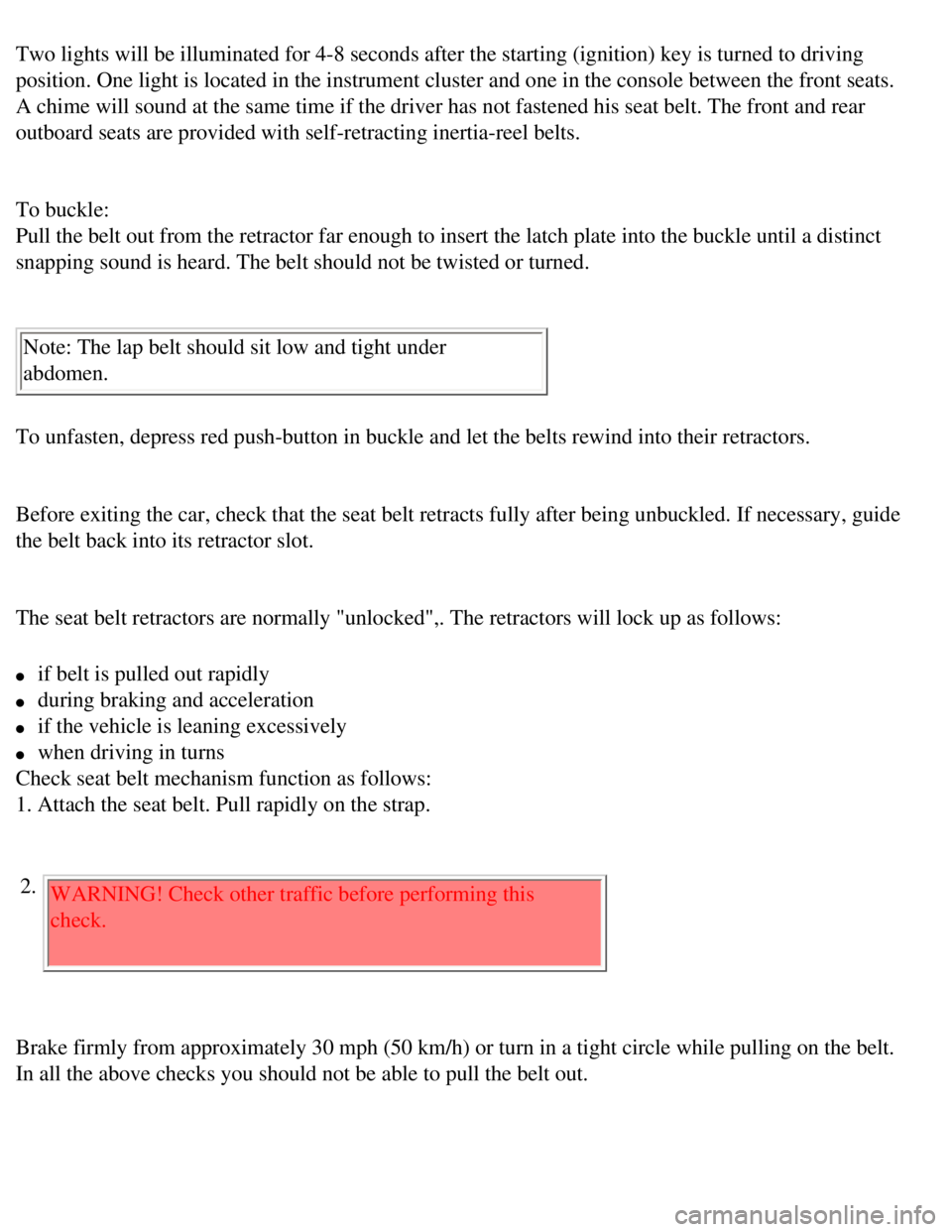
Volvo 1990 240 Model
Two lights will be illuminated for 4-8 seconds after the starting (igni\
tion) key is turned to driving
position. One light is located in the instrument cluster and one in the \
console between the front seats.
A chime will sound at the same time if the driver has not fastened his s\
eat belt. The front and rear
outboard seats are provided with self-retracting inertia-reel belts.
To buckle:
Pull the belt out from the retractor far enough to insert the latch plat\
e into the buckle until a distinct
snapping sound is heard. The belt should not be twisted or turned.
Note: The lap belt should sit low and tight under
abdomen.
To unfasten, depress red push-button in buckle and let the belts rewind \
into their retractors.
Before exiting the car, check that the seat belt retracts fully after be\
ing unbuckled. If necessary, guide
the belt back into its retractor slot.
The seat belt retractors are normally "unlocked",. The retractors will l\
ock up as follows:
l if belt is pulled out rapidly
l during braking and acceleration
l if the vehicle is leaning excessively
l when driving in turns
Check seat belt mechanism function as follows:
1. Attach the seat belt. Pull rapidly on the strap.
2. WARNING! Check other traffic before performing this
check.
Brake firmly from approximately 30 mph (50 km/h) or turn in a tight ci\
rcle while pulling on the belt.
In all the above checks you should not be able to pull the belt out.
file:///K|/ownersdocs/1990/1990_240/90240_06.htm (4 of 9)12/30/2006 8:\
25:04 AM
Page 39 of 143

Volvo 1990 240 Model
A self-diagnostic system incorporated in the sensor monitors the SRS. If\
a fault is detected, the "SRS"
warning light will illuminate. the light is included in the warning/indi\
cator light cluster in the instrument
panel. Normally, the SRS warning light will be illuminated along with th\
e other warning/indicator lights
when the ignition key is turned to the ON position (position II), and \
go out a short time after the engine
has been started. Check that this light is functioning properly every ti\
me the car is started.
The following items are monitored by the diagnostic system:
l Sensor unit electronics integrity.
l Reserve energy supply.
l Diagnostic output circuit.
l System voltage.
l Integrity of system connectors.
l Mercury switch closure.
l Gas generator ignitor
WARNING! If the SRS warning light stays on after the engine has started \
or if it comes on while you
are driving, drive the car to the nearest authorized Volvo Dealer for in\
spection as soon as possible.
ATTENTION! SRS VEHICLE!
THIS CAR IS EQUIPPED WITH A SUPPLEMENTAL RESTRAINT SYSTEM. TO PROVIDE
CONTINUED RELIABILITY, CERTAIN ELEMENTS OF THE SUPPLEMENTAL RESTRAINT
SYSTEM SHALL BE SERVICED OR REPLACED BY 1999. SEE OWNERS MANUAL FOR
FURTHER INFORMATION.
VOLVO
There is no maintenance to perform on the SRS yourself. The only periodi\
c maintenance recommended
on the SRS is that the air bag module and the sensor unit should be repl\
aced every ten years and that the
other components in the system (wiring, connectors, etc.) should also \
be inspected at this time. This
service must be performed by an authorized Volvo dealer.
file:///K|/ownersdocs/1990/1990_240/90240_06.htm (8 of 9)12/30/2006 8:\
25:04 AM
Page 42 of 143
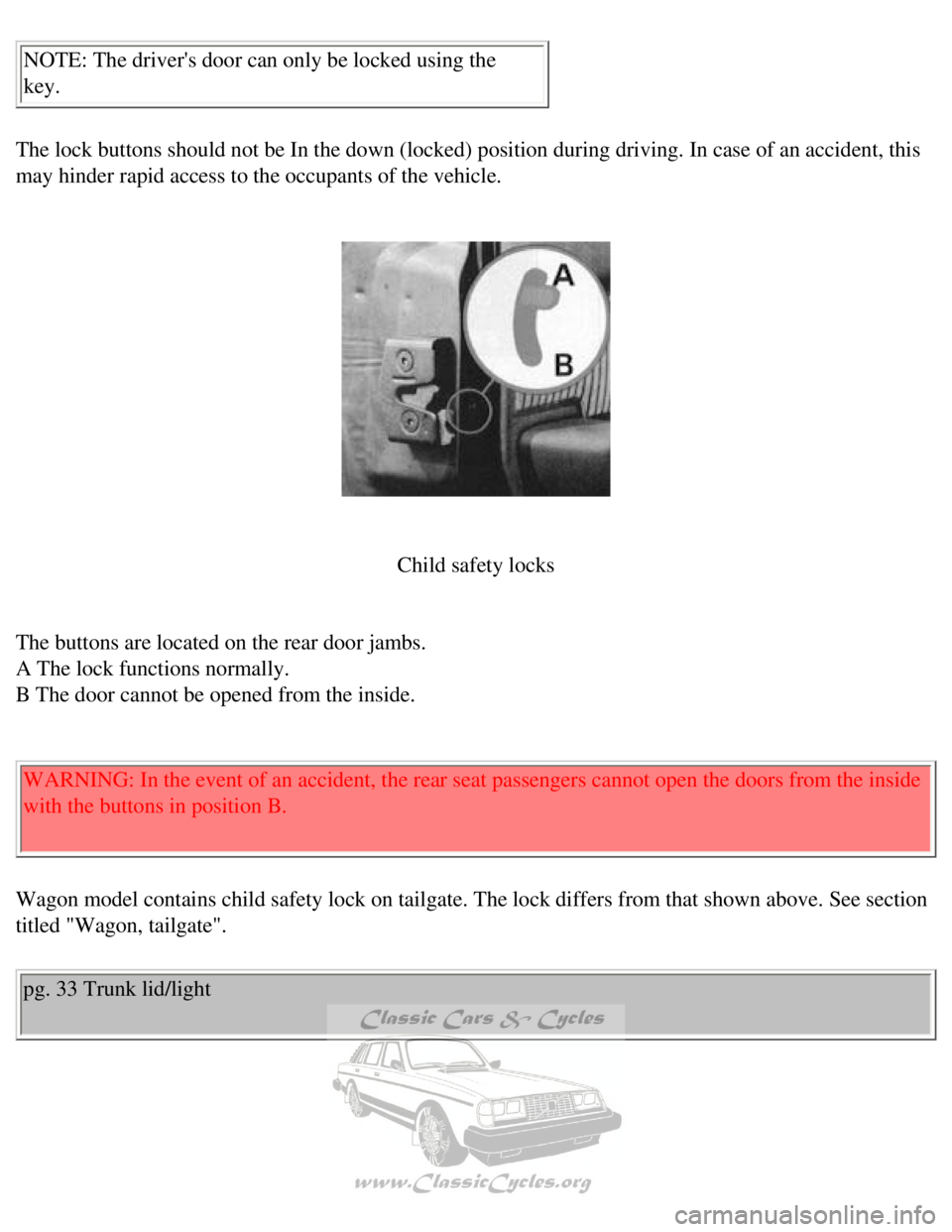
Volvo 1990 240 Model
NOTE: The driver's door can only be locked using the
key.
The lock buttons should not be In the down (locked) position during dr\
iving. In case of an accident, this
may hinder rapid access to the occupants of the vehicle.
Child safety locks
The buttons are located on the rear door jambs.
A The lock functions normally.
B The door cannot be opened from the inside.
WARNING: In the event of an accident, the rear seat passengers cannot op\
en the doors from the inside
with the buttons in position B.
Wagon model contains child safety lock on tailgate. The lock differs fro\
m that shown above. See section
titled "Wagon, tailgate".
pg. 33 Trunk lid/light
file:///K|/ownersdocs/1990/1990_240/90240_07.htm (2 of 6)12/30/2006 8:\
25:04 AM
Page 45 of 143
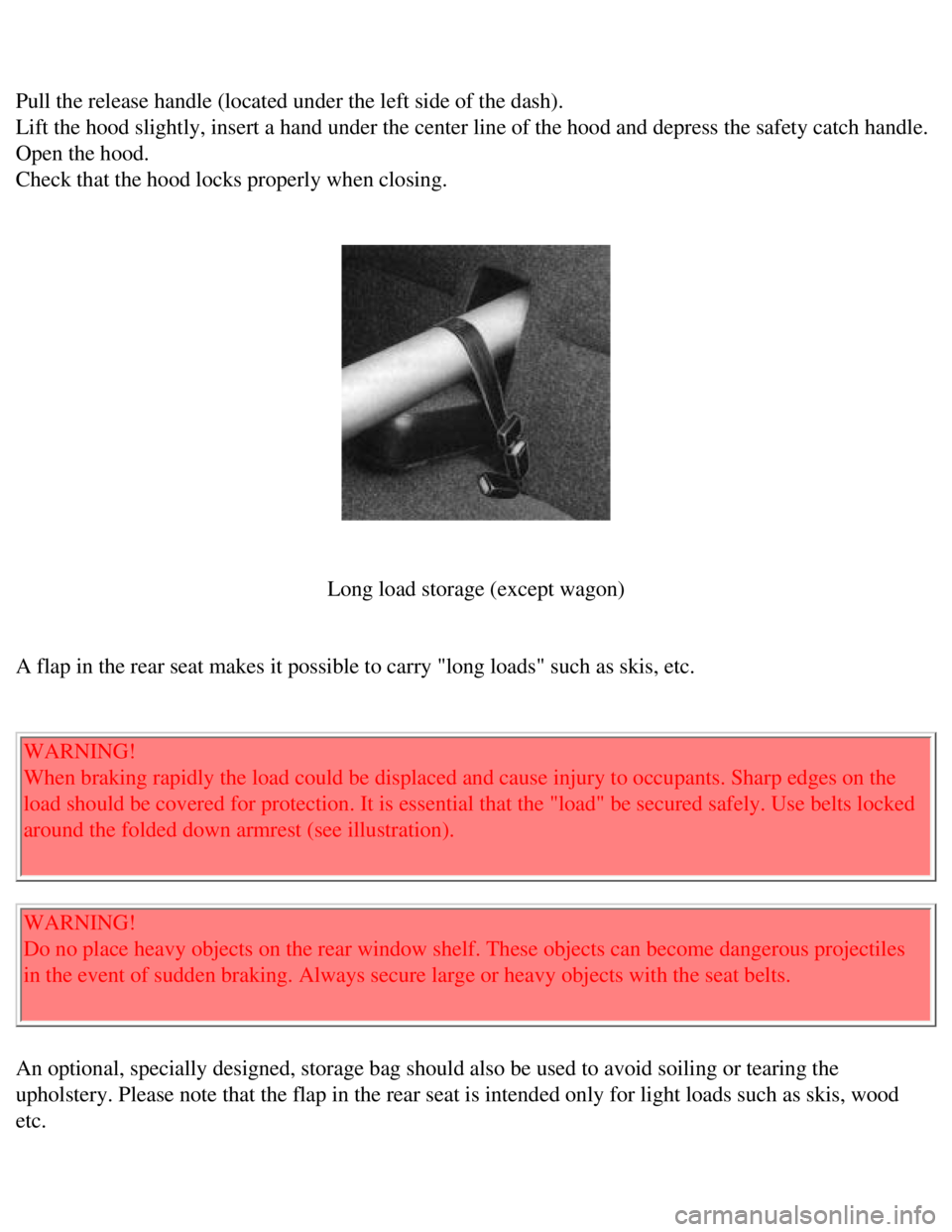
Volvo 1990 240 Model
Pull the release handle (located under the left side of the dash).
Lift the hood slightly, insert a hand under the center line of the hood \
and depress the safety catch handle.
Open the hood.
Check that the hood locks properly when closing.
Long load storage (except wagon)
A flap in the rear seat makes it possible to carry "long loads" such as \
skis, etc.
WARNING!
When braking rapidly the load could be displaced and cause injury to occ\
upants. Sharp edges on the
load should be covered for protection. It is essential that the "load" b\
e secured safely. Use belts locked
around the folded down armrest (see illustration).
WARNING!
Do no place heavy objects on the rear window shelf. These objects can be\
come dangerous projectiles
in the event of sudden braking. Always secure large or heavy objects wit\
h the seat belts.
An optional, specially designed, storage bag should also be used to avoi\
d soiling or tearing the
upholstery. Please note that the flap in the rear seat is intended only \
for light loads such as skis, wood
etc.
file:///K|/ownersdocs/1990/1990_240/90240_07.htm (5 of 6)12/30/2006 8:\
25:04 AM
Page 48 of 143
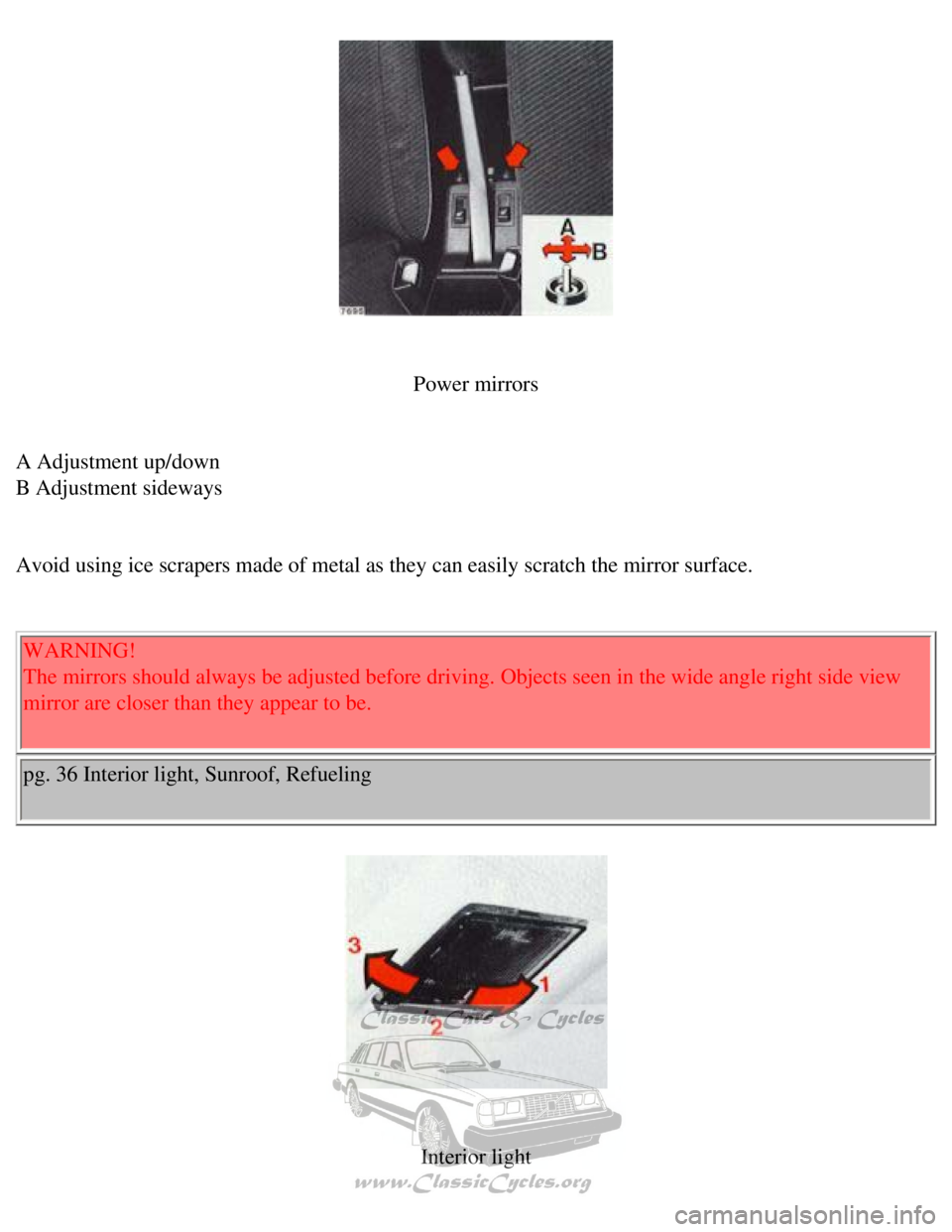
Volvo 1990 240 Model
Power mirrors
A Adjustment up/down
B Adjustment sideways
Avoid using ice scrapers made of metal as they can easily scratch the mi\
rror surface.
WARNING!
The mirrors should always be adjusted before driving. Objects seen in th\
e wide angle right side view
mirror are closer than they appear to be.
pg. 36 Interior light, Sunroof, Refueling
Interior light
file:///K|/ownersdocs/1990/1990_240/90240_08.htm (2 of 4)12/30/2006 8:\
25:04 AM
Page 55 of 143

Volvo 1990 240 Model
Note: Remove foot completely from the clutch pedal after each gear chang\
e when programming the
control unit.
pg. 44 Starting the engine
To start the engine;
1 Enter the car and check that the seat is adjusted properly. Make sure \
that the brake (and clutch) pedal
can be depressed completely. Move the seat closer if necessary.
2 Fasten the seat belt.
3 Apply the parking brake if not already set. Depress the brake pedal wi\
th your right foot.
4 Place the gear selector lever in neutral (position N or P, automatic \
transmission).
5 Depress the clutch pedal (manual transmission).
6 Without touching the accelerator pedal turn the ignition key to starti\
ng position. Release the key as
soon as the engine starts.
Avoid repeated short attempts to start (fuel is injected every time the\
starter is engaged when engine is
cold).
Allow the starter to operate for a longer time (but not more than 15-20\
seconds).
Do not race a cold engine immediately starting.
Engine warm-up-initial driving procedure
Experience shows that engines in vehicles driven short distances are sub\
ject to abnormally rapid wear
because the engine never reaches normal operating temperature.
It is therefore beneficial to reach normal operating temperature as soon\
as possible by driving with a
light foot on the accelerator pedal.
Warning: Always open the garage doors fully before starting the engine i\
nside the garage to ensure
adequate ventilation. The exhaust gases contain carbon monoxide, which i\
s invisible and odorless but
very poisonous.
file:///K|/ownersdocs/1990/1990_240/90240_09.htm (5 of 6)12/30/2006 8:\
25:05 AM
Page 61 of 143

Volvo 1990 240 Model
1. Enter the car and check that the seat is adjusted properly. Make sure\
that the brake pedal can be
depressed completely. Move the seat closer if necessary.
2. Fasten the seat belt.
3. Apply the parking brake if not already set. Depress the brake pedal w\
ith your right foot.
4. Place the gear selector in Park (or neutral).
5. Without touching the accelerator pedal, turn the ignition key to the \
starting position. Release the key
as soon as the engine starts.
6. Select the desired gear. There is a slight delay before the gear enga\
ges which is most notable when
selecting Reverse. Do not accelerate until you have felt the gear engage\
!
Note: Too-rapid acceleration immediately after selecting a gear will cau\
se harsh engagement and
premature transmission wear.
7. Release parking brake, then foot brake, and accelerate. To stop the c\
ar release the accelerator and
apply the brakes with your right foot.
It is not necessary to move the gear selector as the transmission will d\
ownshift automatically.
When idling for extended periods of time, select position N to prevent u\
nnecessary heating of the
transmission.
WARNING! Always place gear selector in Park and apply parking brake befo\
re leaving vehicle. Never
leave car unattended with engine running.
pg. 48 Emergency towing (pulling)
Front eyelet Rear eyelet
file:///K|/ownersdocs/1990/1990_240/90240_10.htm (5 of 7)12/30/2006 8:\
25:05 AM
Page 64 of 143
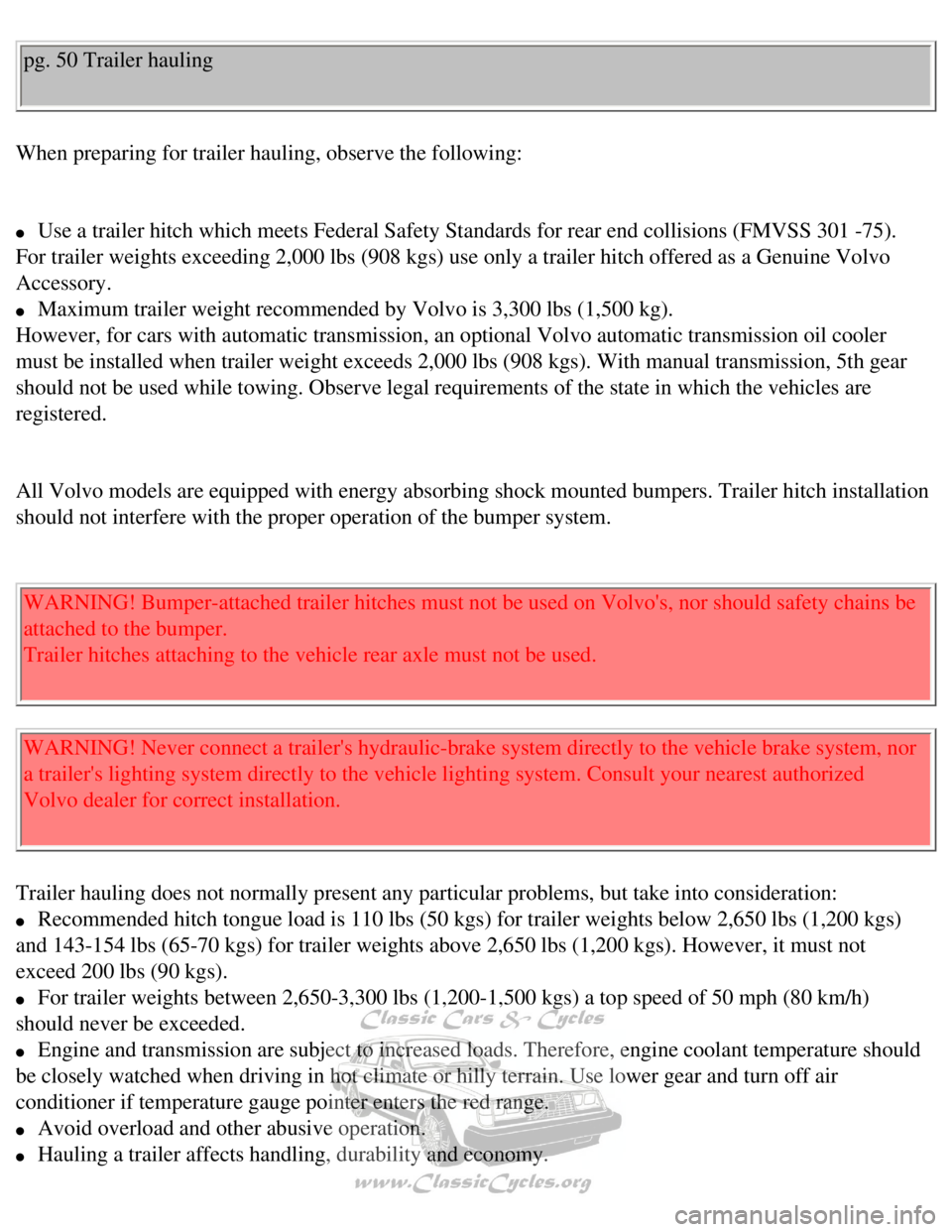
Volvo 1990 240 Model
pg. 50 Trailer hauling
When preparing for trailer hauling, observe the following:
l Use a trailer hitch which meets Federal Safety Standards for rear end co\
llisions (FMVSS 301 -75).
For trailer weights exceeding 2,000 lbs (908 kgs) use only a trailer h\
itch offered as a Genuine Volvo
Accessory.
l Maximum trailer weight recommended by Volvo is 3,300 lbs (1,500 kg). \
However, for cars with automatic transmission, an optional Volvo automat\
ic transmission oil cooler
must be installed when trailer weight exceeds 2,000 lbs (908 kgs). Wit\
h manual transmission, 5th gear
should not be used while towing. Observe legal requirements of the state\
in which the vehicles are
registered.
All Volvo models are equipped with energy absorbing shock mounted bumper\
s. Trailer hitch installation
should not interfere with the proper operation of the bumper system.
WARNING! Bumper-attached trailer hitches must not be used on Volvo's, no\
r should safety chains be
attached to the bumper.
Trailer hitches attaching to the vehicle rear axle must not be used.
WARNING! Never connect a trailer's hydraulic-brake system directly to th\
e vehicle brake system, nor
a trailer's lighting system directly to the vehicle lighting system. Con\
sult your nearest authorized
Volvo dealer for correct installation.
Trailer hauling does not normally present any particular problems, but t\
ake into consideration:
l Recommended hitch tongue load is 110 lbs (50 kgs) for trailer weights \
below 2,650 lbs (1,200 kgs)
and 143-154 lbs (65-70 kgs) for trailer weights above 2,650 lbs (1,20\
0 kgs). However, it must not
exceed 200 lbs (90 kgs).
l For trailer weights between 2,650-3,300 lbs (1,200-1,500 kgs) a top sp\
eed of 50 mph (80 km/h)
should never be exceeded.
l Engine and transmission are subject to increased loads. Therefore, engin\
e coolant temperature should
be closely watched when driving in hot climate or hilly terrain. Use low\
er gear and turn off air
conditioner if temperature gauge pointer enters the red range.
l Avoid overload and other abusive operation.
l Hauling a trailer affects handling, durability and economy.
file:///K|/ownersdocs/1990/1990_240/90240_11.htm (1 of 6)12/30/2006 8:\
25:06 AM